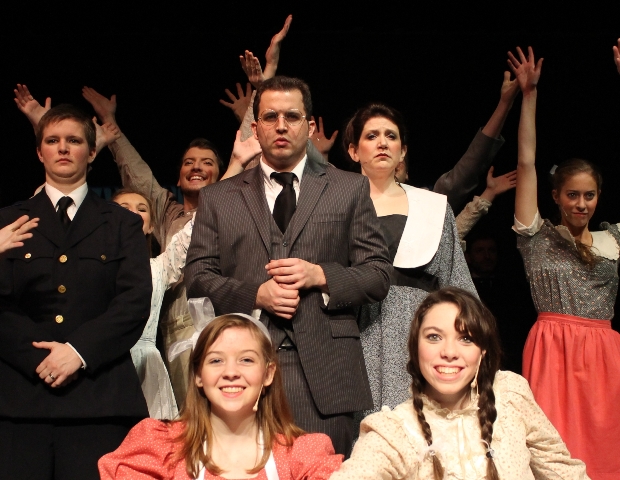
Members of the cast of PARADE at Wilmington Drama League. (Photo credit: Kristin Romero)
Don’t let the festive title fool you: PARADE is about as dark and frightening as a Broadway musical can get. A true horror story about murder, prejudice, and mass hysteria, it’s based on a real 1913 murder case that tore through the heart of Georgia, and eventually the nation. The crime was heinous: young Mary Phagan, just 13, was found brutally murdered in the basement of the pencil factory where she worked. The factory owner, a Jewish Yankee from Brooklyn named Leo Frank, became the prime suspect, and was quickly demonized in the press as the public’s grief turned to anger and vengeance.
PARADE is a many-layered tragedy — one that has never been fully solved, though Frank was posthumously pardoned in the 1980s without a determination of guilt or innocence of the crime. A factory owner who employed young girls earning ten cents an hour (about $2.30 an hour in 2012 money), Frank is as unlikely a sympathetic hero now as he was in 1913. But, through the relatable performance of Brendan Sheehan, he is sympathetic.
If you go in expecting the play to tear white Christian Southerners apart, you might be surprised to find that many of them are sympathetic, too. Yes, there are bigots and opportunists, but it’s hard not to empathize with the people of Marietta in the wake of the murder, especially Mary’s family and friends. Mary deserved justice, there’s no doubt about that. All of the black characters, each an employee of Frank, turn on him when things get hot. Jim Conley, played by the scene-stealing George S. Fletcher III, gave the most damaging testimony of the trial to a wild-eyed jury (and wound up serving time himself as an accessory to the crime), making Leo Frank the first white man convicted on the testimony of a black man in the South.
But “white,” in the eyes of many Georgians, Leo Frank was not. He was painted as a greedy and lecherous Jewish caricature who preyed on young girls. During his trial, girl after girl gave the same disturbing testimony, all accusing him of what we’d now call sexual harassment (or worse, considering they were minors). By contrast, beautiful young Mary was nothing but innocent. We still see sensationalized, circumstantial cases today that create intense public hatred. In Leo Frank’s case, he was convicted on circumstantial evidence and a secondhand confession and given the death penalty. When the verdict came down, people danced. When the celebrations ended, some black observers predicted that Frank, wealthy and white, would be spared the gallows. They were both right and devastatingly wrong.

Ben Walker (Frankie Epps) and the cast of PARADE, running at Wilmington Drama League through February 11. (Photo credit: Kristin Romero)
If this all sounds like a lot for a small community theater to handle — the emotional subject matter, the shocking nature of the events, and the challenging Broadway musical pieces — it definitely is. The Wilmington Drama League, under the direction of Chris Turner, was up for the task, and I say without hesitation that they pulled it off completely. In addition to the standout performances of Brendan Sheehan and George S. Fletcher III, Patrick Sutton is both darkly comical and sinister as Britt Craig, the journalist who revels in the sensationalism of Mary’s murder; Jeffery Santoro is appropriately stomach-turning as unethical prosecuting attorney Hugh Dorsey; and, as Leo’s wife Lucille (the real hero of the story), Rebecca Gallatin shines. Some lighter moments — and there are a few — are provided by Jason S. Tokarski as the charismatic Governor Slaton and Ron Ozer as prison guard Mr. Peavy.
And then there are the youth, whose performances could easily make or break the production. From scanning the bios, it appears that nearly all of the young leads are students at Cab Calloway Scool of the Arts. They must be doing something right, because all of them appear incredibly well-trained and highly talented. Christina Wyatt’s Mary is just perfect. Other standouts include Emily Ozer as Mary’s friend Iola and Benjamin Walker as Frankie, the flirtatious boy turned vengeance-consumed young man.
The stage itself has a minimalist set, designed by Christina Bartley and Chris Turner. A pair of stairs and a few props were all it needed, as well as wonderful period costuming by Crissy Montgomery. The backdrop is a screen, where images of interiors and exteriors set the scene at times, and where, at others, real-life images of newspaper clippings and photos helped tell the stories. The images are incredibly powerful and sometimes graphic. I would have liked to have seen the images even bigger on the screen, but they were very effective as it was. Other than a few technical sound problems with the microphones, the show went off without a hitch.
While it shows Frank as innocent of every accusation, PARADE doesn’t tie things in a neat bow. It doesn’t tell you who the killer was, if not Frank. There is, as in the real-life story, no happy ending or even a real sense of closure. That’s not to say that it left me unsatisfied. On the contrary, PARADE left me with plenty to think about, and a renewed sense of awareness of the damage sensationalism and vitriol can cause, even today.
PARADE
Book by Alfred Uhry
Music & Lyrics by Jason Robert Brown
Directed by Chris Turner
Music Direction by Steven Weatherman
Choreography by Barbara Walker
January 27 – February 11, 2012
Wilmington Drama League
10 West Lea Boulevard
Wilmington, DE 19802
302-764-1172
wilmingtondramaleague.org



2 comments
You can pick your own seats online, no extra fees! Here is the link directly to the ticketing site: https://www.vendini.com/ticket-software.html?e=2ab04e2391662ed52e9a13d6ad2825cf&t=tix
They also have a student rush! Hour before each performance, 20 student tickets go on sale for $13 a piece! Valid high school or college ID required. One discount per person!